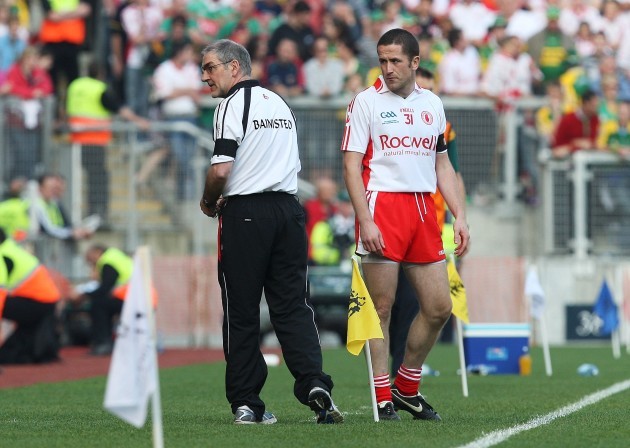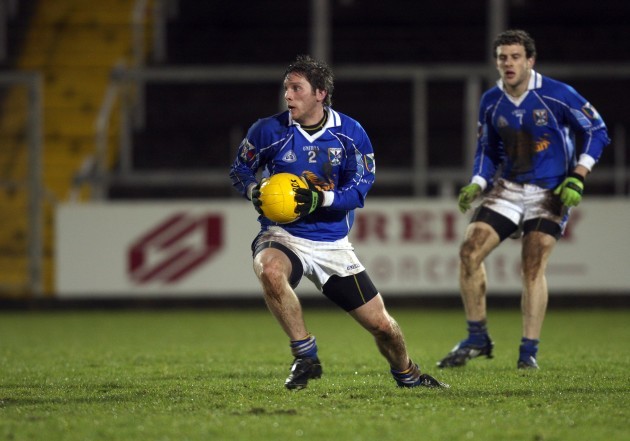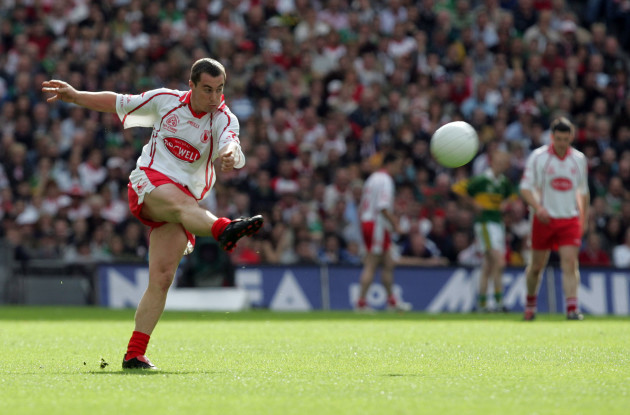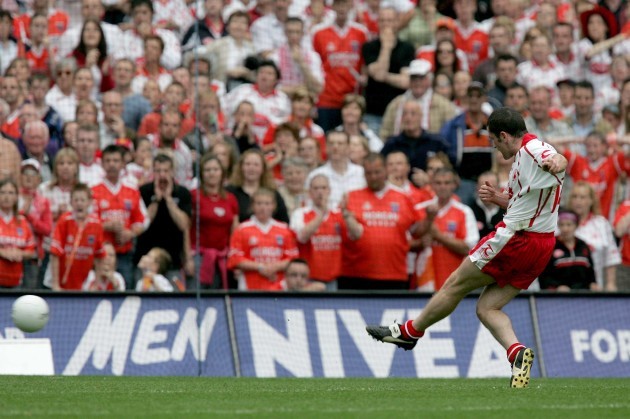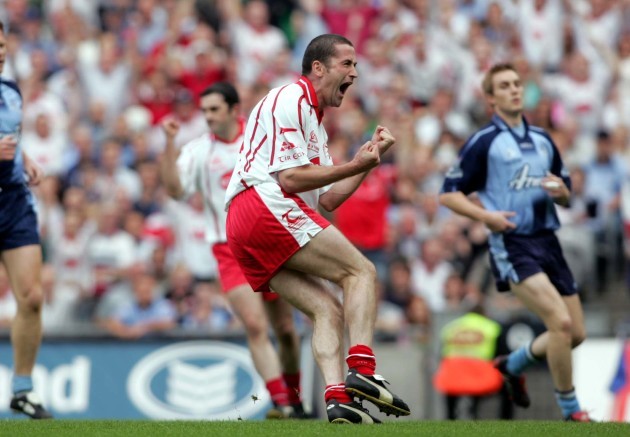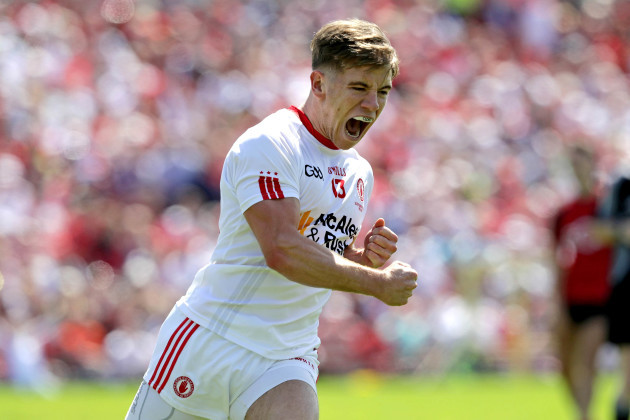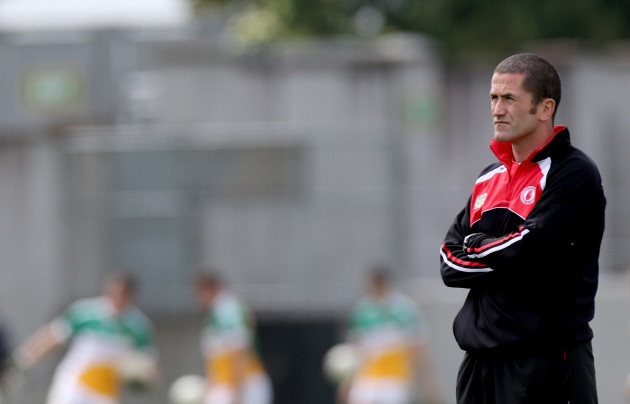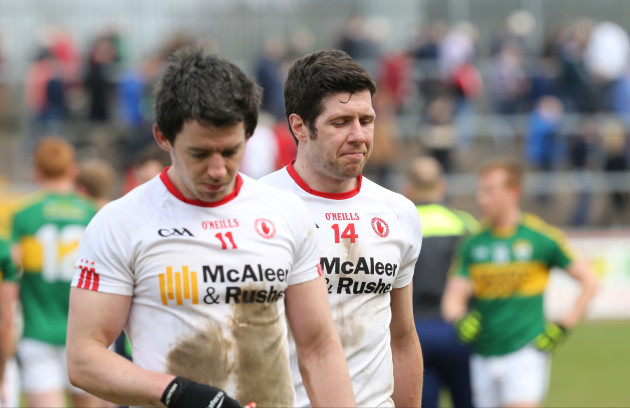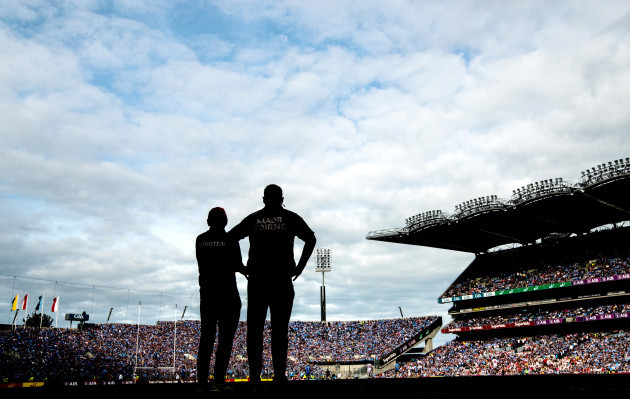SOMETIMES, A SMALL decision can change the course of history.
In his documentary ‘Micko’ which airs tomorrow night, legendary manager Mick O’Dwyer credits the discovery of Eoin ‘Bomber’ Liston in the winter of 1977 as “the missing link” that allowed Kerry string together seven All-Irelands between 1978 and 1985.
Jim Gavin’s call to bring in Jason Sherlock as Dublin forwards coach in the 2014 off-season helped the Sky Blues form a style of play to take down the mass defence. They’ve lost just two games since – both in the league – and have won three All-Irelands in succession.
“I think it brings a freshness to it,” Gavin said after Sherlock’s appointment three years ago.
“Players are used to a particular themes and concepts coming from a manager and to have a skills coach like Jason who is a deep thinker on the game and thinks outside the box.”
It was fascinating to hear news last November of Stephen O’Neill’s appointment as Tyrone’s forwards coach for the coming season.
Like Sherlock, O’Neill is a former All-Ireland winner who played the game with flair and ingenuity. While Sherlock and Gavin won an All-Ireland together on the field of play in 1995, Mickey Harte and O’Neill also have a relationship that dates back to the 1990s.
With Harte as his manager, O’Neill won All-Ireland minor, U21 and senior titles with Tyrone during the most illustrious period in the county’s history.
Is Harte’s introduction of the 2005 Footballer of the Year a sign that he’ll tweak his system, like Dublin did when Sherlock came in?
Whether O’Neill is the man to help Tyrone deliver their first Sam Maguire since 2008 is unclear. But while he may be unproven as a coach, on the field O’Neill was undoubtedly one of the finest players of his generation.
“As a player his movement was brilliant, his footballing IQ was superb and obviously his technical ability,” former Cavan defender Michael Hannon tells The42.
“He was a very technically gifted player and also tuned-in to what was going on in the game.”
Hannon was a tight-marking corner-back, who picked up O’Neill on several occasions in the mid-2000s. These days he teaches in his native Cavan and writes an excellent column for the Anglo Celt newspaper during the GAA season.
The 34-year-old Drumgoon man recalls marking the three-time All-Star when he was at the peak of his powers in the 2005 Ulster semi-final. Hannon got a front-row seat to O’Neill’s game-intelligence that afternoon in Clones.
“I didn’t start on him but I got moved onto him,” says Hannon. “I just remember thinking, ‘This guy isn’t moving the way a footballer would normally move.’ There was something counter-intuitive by the way he was moving.
“I was marking him and normally the forward would run one way, but he was running in the other direction a lot. I my head I was going, ‘What is he doing? What is going on here? It doesn’t seem to make sense.’
“Then sure enough 10 seconds later he’d have the ball in his hand and would put it over the bar. I knew there was something funny going on. My instinct was telling me there was something else happening out the pitch that I couldn’t quite work-out what it was.”
A couple of years later, Hannon got chatting to one of O’Neill’s teammates at a GPA dinner dance. Still bugged by O’Neill’s unorthodox movement from 2005, he asked the Tyrone man to shed some light on it.
“He started laughing,” recalls Hannon. “He told me all about it. Brian McGuigan at centre-forward was playing on a string with Stephen O’Neill, who was at the full-forward.
“From basketball, playing on a string essentially means that wherever one player goes, he pulls the other player with him on the court. You’ll often find the point guard might play on a string with the shooting guard and when one cuts in, the other rotates around.
“But on the football field what was happening was, McGuigan was moving down the field and wherever he went, O’Neill kept 35 or 40 metres between himself and McGuigan. So when McGuigan went all the way into the half-back line, he pulled O’Neill on the other end of the string into the midfield area.
“When he went around to one wing, O’Neill went to that wing but there was always 40 yards or so between them. And any time McGuigan got the ball, he just had to turn around and within a second O’Neill made a dart to get the ball. A lot of Tyrone’s play went through McGuigan. He popped up everywhere and got on the ball, but he always had the option of turning around and feeding the ball into O’Neill.
“It takes two very intelligent players to make that work. A lot of play is going to go through them.”
At 37, O’Neill is still playing club football with Clann na nGael. After a historic 14-year inter-county career that delivered three All-Irelands, five Ulsters and a pair of National League titles, he’s now back on the county scene 20 years after the minor All-Ireland triumph that sparked his career.
Peter Donnelly and Gavin Devlin are back in tow for another year, meaning Harte has three players from the great noughties team in his backroom set-up.
And they’ve got plenty of work to do if the Red Hand are to replicate the success of that all-conquering side.
While Tyrone have reasserted their dominance in Ulster, they’ve badly faltered in the All-Ireland series in recent times. Harte’s side blitzed their way past the northern teams last summer, winning four games by an average of 11.5 points to get to All-Ireland semi-finals. They put up scores of 0-22, 1-21, 2-17 and 3-17 to suggest that their forward play was just fine.
Then they met Dublin, who tore Tyrone to shreds, winning out comfortably by 2-17 to 0-11. It was a walk in the park for Dublin and the game was seen by many as the death knell for defensive football.
A year earlier, Tyrone lost by a point in the quarter-final to Mayo after inexplicably failing to score for the last 10 minutes of the game. To compound matters further, Tipperary were awaiting the winners the last four. Tyrone let slip a golden opportunity slip to make their first final since 2008.
Tyrone’s gameplan last summer was relatively straightforward one. Without possession, they typically dropped 14 behind the ball with Mark Bradley left up front as a lone attacker. Once they regained the ball, they’d break forward in unison and punish the opposition on the counter-attack.
On paper, it looked like the perfect system to take down Dublin, but Gavin’s men patiently picked Tyrone’s defensive shell apart. While Tyrone were preparing to take down the Dubs, Sherlock and Gavin had perfected a gameplan to ruthlessly expose even the tightest of blanket defences.
“Tyrone thought they had a gameplan that was going to be able to beat Dublin, but Dublin showed last year that they don’t,” explains Hannon.
“There’s no team who’ve mastered playing against the mass defence as well as Dublin have. The mass defence will keep Tyrone in the game against other teams, but Dublin are able to score against it.
“So they need to get better at the other end of the field when they play Dublin. They’re probably like any other county out there, they need to have a gameplan against everybody and then a separate gameplan against Dublin.
“They have two things to do: If they’re going to beat Dublin they have to get better at the other end of the field. They need to get better at defending with less players, and get better at attacking with more. That’s the reality of it.”
That’s where O’Neill comes in. But Hannon wonders whether he’ll be given license to tactically tinker with the Tyrone system or whether he’ll be more focused on skills coaching.
“My first thought when I heard he was in as a coach is: what kind of capacity is he going to be coaching?
“You look at Mickey Harte and you wonder, will he be used to coach the two or three players that are up the field? Is he being brought in with a tactical remit? As in, to bring something different to their attacking play, or is he being brought in as a technical coach just to work with their technical ability?”
There’s a perception out there that Harte is an Arsene Wenger-type who’s unwilling to compromise, but recent noises from the Tyrone camp would suggest that O’Neill will indeed be working on evolving their offensive play.
“Stephen O’Neill has been in helping and his instincts would be more towards the attacking side of the game,” newly-appointed captain Mattie Donnelly told the Irish News this week.
“He’s doing a lot of good work with the team, but that’s going to take time and that’s going to take games and patience from all involved before you see that come to fruition.
“Obviously that final third, which is extremely decisive in a big game, is something where we have a lot of scope to improve on too. But I would be happy that we have all the answers there in the set-up at the minute to be able to address that.”
Last November, Sean Cavanagh told the Tyrone Constitution newspaper he felt O’Neill’s introduction could be “final piece in the puzzle for this team.”
“It’s what I felt is missing from our play in the last few years,” Cavanagh stated.
“In Stephen O’Neill, there’s probably no better instinctive forward that I have ever played with. Stevie had that instinctive forward movement, that is hard to coach. And if Stevie can pass any of that on to the Ronan O’Neills, the Mark Bradleys of this world, boy Tyrone will be a hard team to live with.
“If Stevie can help a few players, give them that wee bit more confidence, teach them about diagonal running. Stevie was man-marked and double-marked for most of his career, and that’s what happens nowadays in football, players are double-marked and it can be hard to find space and oxygen in there.”
The recently retired star added: “But with clever runs, with those diagonal runs Stevie used to make, it could help. Stevie’s movement was as good as anyone I have ever seen in terms of those runs that threw off the shackles of defenders. So if he can do that, it will make Tyrone a serious proposition through 2018.”
So what exactly are the changes needed to turn Tyrone into a team capable of beating Dublin? They’ve undoubtedly got attacking riches in Mark Bradley, Ronan O’Neill, Niall Sludden, Darren McCurry, Lee Brennan and Connor McAliskey, who’s back after a suffering a torn ACL 12 months ago.
“Anybody that saw the Dublin semi-final last year would have realised that Tyrone need to evolve – probably at both ends of the field,” Hannon says.
“Maybe Dublin exposing their mass defence as being unfit for purpose the way they did could be an opportunity for them to say, ‘You know what, we’re going to have to push a few more players up the field and get better up the other end of the field.’
“Because having the bodies at the back against the really, really top teams like Dublin, it’s just a waste.
“In my view Tyrone were very strong in terms of having a transition fast-break attack, but they probably weren’t as good as some of the other top teams in terms of having a half-court offense.
“How they’d go about breaking down a team that is already set-up defensively. That’s where they need to improve their attacking play. If they do that fast transition and they don’t get a score from it, they’re left hand passing the ball around to each other and the other team has loads of men back.
“That’s really where Dublin have brought their game to another level. They’re quite comfortable playing against the mass defence as they showed against Tyrone last year so Tyrone probably need to elevate that aspect of their game.
“It will be interesting to see what O’Neill brings to the table in terms of that as well.”
The42 has just published its first book, Behind The Lines, a collection of some of the year’s best sports stories. Pick up your copy in Eason’s, or order it here today (€10):

